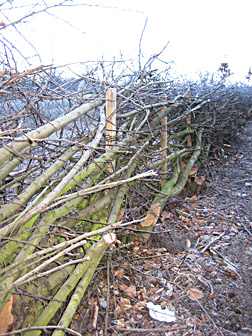Laying a Hedge
Preparing for Hedge Laying
Hedge laying is one of those techniques that are easier to describe than to carry out in practice. Consequently, you would be wise to take extra care at each stage if you are to avoid serious damage to the hedge and possibly even harm to yourself.
Before it is layed, the hedge needs to be tall enough. As a rough guide, you should start with a hedge that is at least twice the height that you want it to be after you have layed it. This allows sufficient length of branches to be bent over and woven into the remainder of the hedge.
If you are starting with a newly planted hedge, you may need to wait a couple of years for it to attain sufficient height.
On the other hand you don't want a hedge to be too tall or you will find it very difficult to manipulate the branches. If the hedge has been allowed to grow too tall, it may need some heavy pruning beforehand.
Since the upright stems need to be partly cut through, sufficient to allow them to be bent over, it is better if they are not too thick. Otherwise, apart from the risk of causing irreparable damage to the plant, the physical effort required will be so much greater.
You need to start with a clear patch, so remove all the rubbish that tends to accumulate in the hedge bottom. Apart from making the work more pleasant, it is easier to remove debris at the start than it is after the hedge has been layed.
It's also worth cutting back excessive ground cover that would make it difficult to see where you are working. While you are at it, cut out any dead wood and possibly prune out any large side branches if they are likely to hinder the process of bending and securing the trunks.
Laying the Hedge

Choose your time
The work of laying a hedge should be scheduled for the winter months. After all, hedge laying is drastic surgery for the hedging plants and therefore the work should be carried out when the plants are dormant and the sap is down.
Take your time
When all preparations have been made, start at one end of the hedge and work on each individual plant in turn. Carefully cut into the trunk of the plant at the base. The cut should be just sufficient to allow the trunk to bend and no more. It is vital that sufficient sapwood and bark is left intact so that the plant can continue to draw nourishment from the ground.
The importance of taking care not to cut too deep cannot be over emphasised and it may take a little practice before you know just how deep each cut should be. It might be worth looking around your locality for a hedge of the same type that has already been layed successfully since this will give you an initial idea of what is required.
As you cut through each stem, you need to bend it over and weave it into the other hedging plants. Each branch should be close to, but not quite horizontal. There needs to be a small upward angle, which will encourage the sap to rise from the base of each stem to the tip. This also provides for the finished height of the hedge, which is typically around four feet but may be varied according to personal preference and the intended function of the hedge.
As you weave each branch into the hedge there is obviously a strong tendency for it to spring out again. For this reason, stakes are driven into the ground on either side of the hedge at intervals of between 18 inches and 30 inches. These may be sawn timber stakes but are often made from coppiced hazel, which gives a more natural and pleasing appearance.
If the top of the hedge is unruly you can weave hazel binders along the top of the stakes to maximise strength or simply to improve the appearance of the freshly layed hedge
Read more about Hedges |
Read more about Plants |
